Headlines and events archive
Displaying 51 - 100 of 1944
You may also find an archive of news published in the media which are related with the Instituto de Astrofísica de Andalucía - CSIC.
Pages

|
17/12/2024
The Sunrise III Mission captures unprecedented Solar data with exceptional spatial and temporal resolution An international scientific team, with significant Spanish participation through a consortium led by the Instituto de Astrofísica de Andalucía (IAA-CSIC), has, for the first time, obtained simultaneous data from the Sun in ultraviolet, visible, and infrared light bands. This information was gathered during the successful scientific flight of the Sunrise III mission in July 2024 |

|
12/12/2024 - 12/12/2024
https://indico.iaa.csic.es/event/19/ Granada |

|
21/01/2025 - 30/10/2025
https://www.iaa.es/meetings/academic-spanish-course-foreigners-2025 Granada |
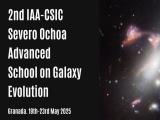
|
19/05/2025 - 23/05/2025
https://www.granadacongresos.com/galevol2025 Granada |

|
30/01/2025 - 12:30
SO Colloquium: Modelling of large-scale magnetic field in low-mass stars Recent spectropolarimetric observations of low-mass stars show that large-scale components of their magnetic fields can exhibit cyclic variations or reversals. This magnetic activity affects detection of exoplanets and estimation of their masses, and so its modelling is particularly important. In convective stellar envelopes, magnetic fields are created through dynamo action - systematic stretching and twisting of magnetic field lines by... Dr. Anna Guseva |
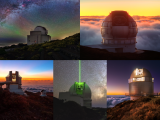
|
05/12/2024
The LPI project to explore new frontiers in quantum astronomy from La Palma The Instituto de Astrofísica de Andalucía (IAA-CSIC) is leading the LPI (La Palma Interferometer) project, aimed at conducting astronomical observations with spatial resolution a thousand times greater than that of the Hubble and James Webb space telescopes. LPI brings together the collaboration of various research centers and institutions from Spain, Italy, the Nordic countries, and Mexico, working together to establish a cutting-edge... |

|
28/01/2025 - 12:30
El crecimiento de la complejidad en el Universo La existencia de vida es uno de los grandes problemas cosmológicos. Aunque la vida sea un hecho observado en un único planeta, el proceso de complejización que supone, debe obedecer a leyes generales universales. Varios autores claman por una “missing law” termodinámica, a la búsqueda de la cual se incorpora la hipótesis que presentamos aquí. El surgimiento y la evolución de la vida son resultado del mismo principio. Se deduce que la complejidad... Dr. Eduardo Battaner |
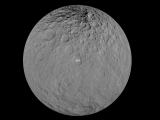
|
02/12/2024
New evidence of organic material identified on Ceres, the inner Solar System’s most water-rich object after Earth Thanks to an innovative approach combining high spatial and spectral resolution, the Instituto de Astrofísica de Andalucía (IAA-CSIC) has analyzed the distribution of organic compounds on Ceres with unprecedented detail This study paves the way for a potential future return to Ceres to clarify the nature of the detected material and examine its astrobiological implications |

|
23/01/2025 - 12:30
Study of the very high energy emission from star-forming regions and young massive star clusters Cosmic rays (CRs) are a fundamental component of the Cosmos. They can penetrate and ionise the dense gas core of molecular clouds, affecting the dynamics of the cloud itself and triggering chemical reactions that lead to the creation of complex molecular compounds. In star-forming complexes, CRs can be accelerated by the wind of newly born massive stars, often found in young massive stellar clusters (YMSC). The amount of freshly injected CRs can... Dr. Gaia Verna |
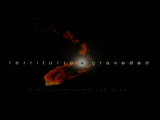
|
27/11/2024
‘Territorio gravedad’, the Spanish docu-series about the cosmos, returns with its second season The four new episodes of the series, produced by the Instituto de Astrofísica de Andalucía (IAA-CSIC), will be available from 29 November on Filmin and Vimeo On Demand |

|
31/01/2025 - 12:30
Resolving Stellar Angular Diameters with Asteroid Occultations Occultations have been used for measuring stellar angular diameters since 1936 when French astronomy M. A. Arnulf measured the radius of Regulus during a lunar occultation. Since then, astronomers have used lunar occultations to measure the angular diameters of hundreds of bright stars m≤5. The technique of measuring an angular diameter using lunar occultations is based on the diffraction of light around the limb of the moon. With this technique... Joshua Bartkoske |

|
02/12/2024 - 02/12/2024
https://indico.iaa.csic.es/event/18/ Granada |

|
20/11/2024
The J-PAS Astronomical Project releases the first data from its mapping of the Universe The project, co-led by the Instituto de Astrofísica de Andalucía (IAA-CSIC), has made available to the scientific community the first twelve square degrees of the three-dimensional map of the Universe being developed from the Javalambre Astrophysical Observatory (OAJ). The studied area contains 550,000 astronomical objects and represents just a small sample of the survey's data, which aims to cover thousands of square degrees over the next... |

|
31/10/2024 - 31/10/2024
https://indico.iaa.csic.es/event/17/ Granada |

|
03/12/2024 - 12:30
Experimental ice simulations for the interpretation of ice and organics observations in the Solar System The harsh conditions in space (ultra-high vacuum, cryogenic temperatures, and radiation) are simulated in laboratory chambers to study ice properties and processes. UV photons/X-rays/ions impact on the ice covering microscopic dust particles in dense interstellar clouds, comets, icy moons and planetary surfaces. Radiation produces radicals and reactive species changing the initial composition of the ice (made of simple species like... Dr. Guillermo Muñoz Caro |

|
12/12/2024 - 12:30
Informative Session for Foreign New Hires If you are a foreigner who has recently joined the IAA and haven not yet completed all the steps to formalize your residency in Spain, or if you would like to learn about some of the optional bureaucratic procedures that could make things easier for you living here, please join us for this informative session led by the Area of Visitor Assistance. Lauren C. Smith |

|
25/11/2024 - 25/11/2024
https://indico.iaa.csic.es/event/20/ Granada |

|
13/11/2024
Signal of a Binary Super Massive Black Hole System interacting with a gas cloud detected for the first time The Instituto de Astrofísica de Andalucía (IAA-CSIC) contributed to this study by providing key data obtained with its ALFOSC spectrograph, installed on the Nordic Optical Telescope (NOT) at the Roque de los Muchachos Observatory in La Palma. This information complements data from NASA’s Neil Gehrels Swift Observatory and the ZTF project. |
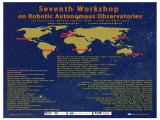
|
16/10/2024 - 20/10/2024
http://astrorob.iaa.es Torremolinos |
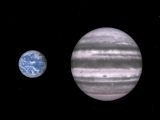
|
31/10/2024
Several Neptune-like planets discovered in a theoretically barren region The study, focusing on the planetary nature of thirteen objects of interest from the TESS mission, confirms the existence of five new planets around red dwarf or M-type stars, which are smaller and cooler than our Sun. The planets lie within or very near the "Neptunian desert," a region noted for the scarcity of planets with characteristics similar to those of Neptune. |

|
10/12/2024 - 12:30
ESERO, from space to the classroom With the slogan ‘from space to the classroom’, and building on the fascination that students have for space, the European Space Agency's (ESA) European Space Education Resource Office in Spain (ESERO Spain) provides resources to primary and secondary school teachers to improve their literacy and STEM (Science, Technology, Engineering and Mathematics) skills. Using the theme of space as a context for inspiration and motivation, ESERO runs a... Dr. Manuel González |

|
14/11/2024 - 12:30
Ozone and the Search for Life in the Universe As we approach the era where we will be able to characterize the atmospheres of terrestrial exoplanets, we are put on a path to answer one of humanity's most compelling questions: are we alone in the universe? Molecular oxygen (O2) with a reducing gas (i.e., methane) is widely regarded as a promising biosignature - a sign of life in the atmospheres of terrestrial exoplanets. However, there are circumstances in which O2 will be very difficult or... Dr. Thea Kozakis |

|
06/02/2025 - 12:30
Equality and harrassment in the CSIC. A case of study: IAA In this talk I will present the equality plans in the CSIC with a critical look at the particular situation of the IAA. I will focus on the current IAA Equality plan (the first one) and the changes it needs to live in an increasingly friendly environment. Equality will have a positive impact on the quality of the science we produce. Dr. Josefa Masegosa Gallego |
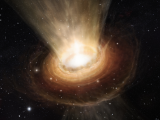
|
15/10/2024
Supermassive black holes alter the chemical evolution of galaxies The IAA-CSIC participates in this study that shows how the activity of a supermassive black hole hidden in the heart of a quasar has transformed the chemical composition of the gas in the galaxy. |

|
31/10/2024 - 12:30
Using CHEOPS to confirm small transiting exoplanets orbiting bright stars Exoplanets which transit their host stars are unique in allowing detailed characterisation of planetary radius, mass and atmospheric properties. NASA's TESS mission, which has so far observed 97% of the sky with precise photometry, is especially adept at detecting small transiting planets orbiting the brightest... Dr. Hugh Osborn |

|
31/12/2025 - 12:30
SO Colloquium: Bursting and cool slowly rotating stellar zombies The large efforts put into studying the transient Universe in the past years allowed the discovery of a variety of new astrophysical classes and events, many of them proposed to be related to the formation of a neutron star or a magnetar, the most magnetic pulsars. Pulsars are unique astronomical laboratories where the most extreme gravity and electromagnetism can be probed. The study of these objects transcends the traditional astrophysical... Dr. Nanda Rea |

|
06/11/2024 - 12:30
New UGR proceedings for PhDs Every year we all doubt what needs to be done and uploaded for the university. This is a reminder and updated seminar about the current proceedings that affect the PhD, especially important since the UGR has modified some things recently. Dr. Antonio García Hernández |

|
24/10/2024 - 12:30
SO colloquium: Role of Astrophotonics in Astronomy: The MARCOT Pathfinder Dr. Kalaga Venu Madhav, a renowned astrophysicist from the Leibniz Institute for Astrophysics Potsdam, will present a colloquium on the role of astrophotonics in astronomy, focusing on the MARCOT Pathfinder project. The talk will cover advancements in astrophotonic technologies and their applications in modern astronomical instrumentation. Dr. Madhav will discuss the development and implementation of photonic devices in telescopes, their impact... Dr. Kalaga Madhav |

|
21/11/2024 - 12:30
Towards the Standardization of the Modeling of Multi-Frequency Observations Blazars, a class of Active Galactic Nuclei (AGN) with relativistic jets oriented toward Earth, are powerful and highly variable emitters across the electromagnetic spectrum. Time-domain multi-messenger and multi-wavelength (MWL) studies are essential for understanding the physical processes at work on these systems, yet they often rely on proprietary tools specific to each instrument for reconstructing and modeling the collected data. In this... Dra. Mireia Nievas Rosillo |

|
26/11/2024 - 28/11/2024
https://indico.iaa.csic.es/e/HighEnergyPulsars |

|
05/09/2024
IAA-CSIC researcher Rafael Luque receives a ‘Starting Grant’ from the European Research Council The grant, 1.5 million euros over the next five years, will help to understand the properties of subneptune-type planets. |
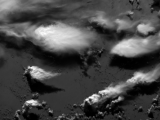
|
23/08/2024
JANUS, the optical camera on ESA's JUICE probe, captures stunning images during its first lunar and terrestrial flyby JANUS, the optical camera on ESA's JUICE probe, captures stunning images during its first lunar and terrestrial flyby |

|
27/09/2024 - 12:30
Who Is Afraid of the Dark (Energy)? Cosmic acceleration dominates the behavior of the recent universe, with some fundamentally new physics at its heart. Recent data gives a tantalizing suggestion that the dark energy behind it is more complicated than a cosmological constant. Nevertheless, we do know a lot about how to describe dark energy behavior. Data within the next year has great promise to give further insight, and exciting new instruments are being planned. Dr. Eric Linder |

|
10/10/2024 - 12:30
Uncovering the magnetized path of massive star formation Both observational and theoretical studies suggest that the magnetic field plays an important role in the process of massive star and cluster formation. However, many open questions still remain, including the exact role of B-field at the different scales (from cloud to disk scales) and its importance compared to turbulence, feedback and self-gravity. Multi-scale studies of the morphology and strength of the magnetic field are thus crucial to... Dr. Chi Yan (Paul) Law |

|
07/08/2024
Origin of persistent emission in enigmatic Fast Radio Bursts revealed A new international study involving the IAA-CSIC identifies a plasma bubble as the origin of the persistent emission observed in some fast radio bursts (FRBs) The data also allow researchers to determine the nature of the "engine" that powers these mysterious sources The results are published today in Nature |

|
17/10/2024 - 12:30
SO Colloquium: Radio eyes for the Sun, Heliosphere and Ionosphere: Status and plans for the SKAO era The Square Kilometre Array Observatory (SKAO) represents a monumental leap in radio astronomy technology, promising to redefine our understanding of the universe through its unprecedented capabilities. As we stand on the brink of the SKAO era, this talk aims to elucidate the transformative potential of SKAO for solar physics, heliospheric, and ionospheric research. The SKAO's advanced radio telescopes, with their superior angular, spectral, and... Dr. Pietro Zucca |

|
13/02/2025 - 12:30
SO Colloquium: Present and future of exoplanet research The search for new worlds in the Galaxy in the past three decades has been highly successful and the prospects for the next decade are even brighter. A succession of space missions and ground-based facilities defines a timeline extending well into the 2030s. Many advances on the planet discovery front will come from the PLATO mission, which will find long-period planets and even true Earth analogues, and from the many ongoing and future precise... Dr. Ignasi Ribas |
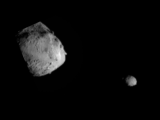
|
30/07/2024
NASA's DART mission captures high-resolution image of the binary asteroid system Didymos The study, which analyzes the geology and origin of this binary asteroid system close to Earth, concludes that the surface of Didymos is between 40 and 130 times older than its satellite Dimorphos The work has been published in five articles in Nature Communications and the IAA-CSIC participates in one of them |

|
28/11/2024 - 12:30
SO Colloquium: Cosmic chemical evolution: here, there, and everywhere Metals play a very important role in star formation and stellar evolution. Amongst other things they control the cooling of the interstellar gas, thus allowing the formation of stars; they affect the radiation transport, through the opacities involved in the different microscopic processes; and they have the most important role in the dust formation and in the mass loss from stars. Metals are formed inside stars. Therefore, it is expected that... Profa. Ángeles Díaz |

|
26/09/2024 - 11:00
The stellar distribution in ultra-faint dwarf galaxies suggests deviations from the collisionless cold dark matter paradigm Unraveling the nature of dark matter (DM) stands as a primary objective in modern physics. I will present evidence suggesting deviations from the collisionless Cold DM (CDM) paradigm. In the standard cosmological model the dark matter (DM) particles are collisionless and, because of this very nature, they develop halos with the characteristic central cusp known as NFW profile. Real galaxies do not show NFW profiles but, rather, have a DM mass... Dr. Jorge Sánchez Almeida |
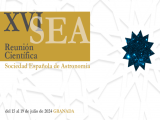
|
15/07/2024 - 19/07/2024
https://www.granadacongresos.com/sea2024 Granada |
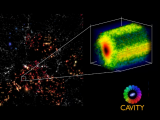
|
15/07/2024
The IAA-CSIC participates in a project that offers the scientific community three-dimensional images of 100 galaxies CAVITY is the name of this international initiative whose objective is to monitor up to 400 galaxies in the future to learn about their formation and evolution The material is now available through the website www.cavity.caha.es |

|
04/11/2024 - 08/11/2024
https://indico.iaa.csic.es/event/16/ Granada |
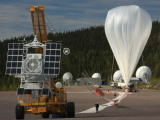
|
10/07/2024
Sunrise III successfully launched This mission has a strong participation of the Solar Physics Group of the IAA. |

|
24/06/2024
The most distant and oldest star clusters discovered The James Webb Space Telescope observes star clusters in a galaxy just 460 million years after the Big Bang. The Instituto de Astrofísica de Andalucía (IAA-CSIC) and the Instituto de Física de Cantabria (IFCA-CSIC-UC) are participating in this discovery. |

|
24/09/2024 - 12:30
Constraining the Meteoroid Flux in the inner solar system The inner solar system is populated by Interplanetary Dust Particles (IDPs) released from cometary trails and collisions between asteroids. Planetary bodies and satellites therefore encounter a cloud of IDPs along their orbits, giving rise to a permanent bombardment on their respective atmospheres or surfaces. Constraining the magnitude of the mass influx of IDPs onto a solar system body is crucial for understanding the effects in their... Dr. Juan Diego Carrillo Sánchez |
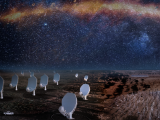
|
21/06/2024
The IAA strengthens CSIC's international role in the SKA Observatory The IAA has been endowed by the CSIC with nearly one hundred thousand euros to strengthen the capacities of the scientific community that will use SKAO through the Spanish SKA Regional Centre. "CSIC4SKA", led by the IAA-CSIC, was one of five projects funded under the CSIC Programme for Large European Research Infrastructures. |

|
23/07/2024 - 12:30
The QUIJOTE experiment: status, latest results and future plans I will review the current status and future plans of the QUIJOTE (Q-U-I JOint TEnerife) experiment, a project with the aim of characterising the polarisation of the Cosmic Microwave Background, and other galactic or extragalactic physical processes that emit in microwaves in the frequency range 10-42GHz, and at large angular scales (1 degree resolution). The project has two radio telescopes (2.25m primary aperture) and three instruments, MFI (10... Dr. José Alberto Rubiño Martín |

|
30/09/2024 - 13:00
High-Resolution Study of Blazar TXS 2013+370 and BEAM: A Space Technology and Research Student Team The talk will focus on two key areas. Part one will present the high-resolution imaging of Blazar TXS 2013+370, a study conducted as part of an M.Sc. thesis. This research aims to resolve the inner jet structure of the compact radio source TXS 2013+370 in total intensity and polarization. This analysis utilizes VLBA data combined with Effelsberg observations at frequencies of 22 GHz, 43 GHz, and 86 GHz. Part two will highlight BEAM, a student... Giorgos Michailidis |

|
20/06/2024 - 12:00
Mujer en la Ingeniería: Avances y Retos En esta conferencia presentaremos, en primer lugar, una panorámica de la situación actual de la mujer en las STEM y en particular en la ingeniería, tratando de analizar qué factores pueden tener una mayor influencia en la situación actual. A continuación trataremos brevemente la educación de la mujer en los dos últimos siglos. Destacaremos el hecho de como las formas de educar a la mujer están directamente relacionadas con el trabajo que... Dr. Laura Roa |